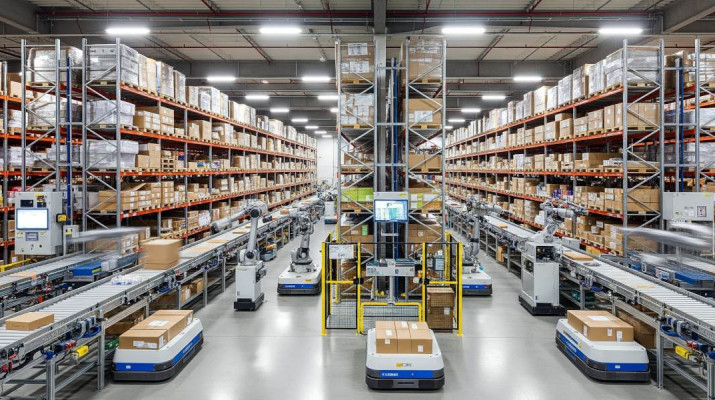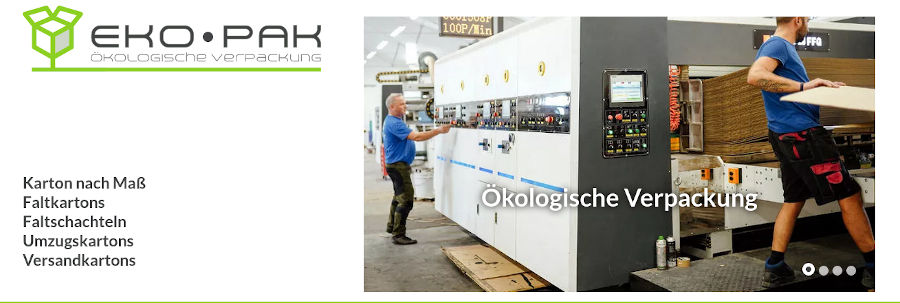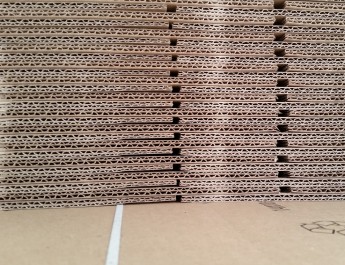Corrugated cardboard is one of the most important packaging materials in the modern world, revolutionizing the way we produce, transport, and store goods. Since its invention in the 19th century, corrugated packaging has become an indispensable element of the global supply chain, influencing nearly every sector of the economy. In this article, we take a comprehensive look at this fascinating material—its properties, applications, environmental impact, and the future of the packaging industry.
History and Evolution of Corrugated Cardboard
Technological Origins
The history of corrugated cardboard dates back to 1856, when British inventors Edward Healey and Edward Ellis patented the first process for producing paper with a corrugated structure. Initially, this material was used as a hat liner to provide better ventilation and comfort. A breakthrough came when it was applied in the packaging industry.
In 1871, Albert Jones of New York patented the use of corrugated cardboard as protective packaging for glass and other fragile items. This marked the beginning of the modern era of cardboard packaging. Further innovations, such as Robert Gair’s introduction of a multi-layered structure in 1890, gradually transformed simple corrugated paper into a sophisticated engineering material.
Technological Development in the 20th Century
The 20th century brought dynamic advances in corrugated cardboard production technology. The introduction of mass production machinery in the 1920s significantly reduced costs and increased availability. Advances in packaging chemistry led to the development of various adhesives and coatings that improved mechanical and barrier properties.
The post-WWII period was particularly significant, as the rapid expansion of international trade and the rise of supermarkets created enormous demand for efficient packaging solutions. Corrugated cardboard met these needs perfectly, offering an optimal balance of cost and functionality.
Structure and Technical Properties
Structure of Corrugated Cardboard
Corrugated cardboard features a unique layered structure that gives it exceptional mechanical properties. The basic structure consists of:
- Outer layers (liners) – Flat sheets of paper or board forming the external surfaces. They can be made from recycled paper or high-quality virgin kraftliner.
- Corrugated layer (medium) – The core, made of paper shaped into a regular fluted pattern. This layer provides most of the material’s mechanical strength, including compression resistance and shock absorption.
- Adhesives – Starch-based glues bond the layers together, ensuring structural integrity.
Construction Types
The packaging industry has developed several standard types of corrugated board:
- Single Face – One fluted layer bonded to one flat layer. Mainly used as cushioning or inner packaging.
- Single Wall – The most common type, with one fluted layer between two flat liners. Typically 3–4 mm thick.
- Double Wall – Two fluted layers separated by three flat liners for greater strength. Thickness: 6–7 mm.
- Triple Wall – The strongest type with three fluted and four flat layers. At 15 mm thick, it’s an alternative to wooden packaging.
Technical Parameters
Mechanical properties are defined by standardized metrics such as:
- Edge Crush Test (ECT) – Measures vertical load-bearing capacity, critical for stacking stability.
- Burst Strength – Indicates resistance to sudden point loads during handling.
- Bending resistance – Important for folding and usability.
- Barrier properties – Includes permeability to water vapor, gases, and contaminants.
Production Process
Raw Material Preparation
The process begins with preparing suitable paper grades. Modern facilities use both virgin fibers (mainly from softwood trees) and recycled materials. Recovered paper accounts for about 90% of raw materials, making corrugated cardboard one of the most eco-friendly packaging materials.
Preparation includes shredding, decontamination, de-inking, and refining the pulp for strength parameters.
Forming the Corrugated Structure
A key stage is forming the fluted layer using a corrugator machine. The medium paper is steamed for plasticity and passed between a fluting roll and a pressure roll to create the wave pattern.
Simultaneously, modified starch adhesive is applied to the flute peaks for optimal bonding and drying time.
Laminating and Drying
The fluted layer is laminated with the flat liners under heat and pressure to ensure adhesion. Modern machines run at speeds up to 300 meters per minute and widths up to 2.8 meters.
Finishing and Conversion
After cooling and conditioning, the board is rolled or cut into sheets per customer specifications.
Applications Across Industries
Food Industry
This sector is the largest consumer of corrugated packaging. Key applications include:
- Fresh produce packaging – Requires ventilation and moisture resistance. Perforations and coatings help maintain product freshness.
- Frozen food packaging – Must remain structurally sound at low temperatures. Special adhesives and coatings resist condensation.
- Reusable packaging – With reinforcements and closures for closed-loop logistics systems.
E-commerce and Online Retail
The e-commerce boom has transformed packaging needs. Corrugated cardboard offers:
- High mechanical resistance – For automated sorting and handling.
- Dimension optimization – To reduce shipping costs and filler material.
- Easy opening – Enhancing customer experience.
- Customization potential – Via digital printing and die-cutting.
Automotive Industry
This sector demands precision and repeatability. Packaging must ensure:
- Dimensional stability – For sensitive components.
- Antistatic properties – For electronic parts.
- Chemical resistance – In manufacturing environments.
- Automation compatibility – With barcodes and RFID tags.
Pharmaceutical Industry
Corrugated packaging for pharmaceuticals must meet strict regulations:
- GMP compliance – For cleanliness and quality control.
- Barrier properties – Against light, moisture, and contamination.
- Validation capability – For regulatory requirements.
- Anti-counterfeit systems – To prevent tampering and fraud.
Technological Innovations
Smart Packaging
Emerging technologies support “smart” corrugated packaging featuring:
- Humidity and temperature sensors – For real-time storage monitoring.
- NFC and RFID tags – For supply chain tracking and authentication.
- Freshness indicators – Color-changing signals for product status.
- AR elements – For consumer interaction via mobile apps.
Nanotechnology
Nanotech applications include:
- Nanocellulose – Adds strength without extra weight.
- Nano barrier coatings – Improve resistance to gases and moisture.
- Antistatic nanoparticles – Reduce electrostatic discharge risks.
- Antibacterial materials – Extend shelf life of food products.
Automation and Industry 4.0
Industry 4.0 integration enables:
- On-demand packaging machines – For custom order fulfillment.
- Computer vision systems – For 100% quality control.
- IoT platforms – For full production network connectivity.
- AI algorithms – For process optimization and maintenance prediction.
Environmental Aspects and Sustainability
Product Life Cycle
Corrugated cardboard has a favorable environmental footprint across its life cycle:
- Raw materials – Use of renewable forest resources and up to 95% recycled content.
- Production – New technologies cut energy use by 25–30%.
- Use phase – Lightweight structure lowers CO₂ emissions during transport.
- End-of-life – 100% recyclable and biodegradable.
Environmental Certifications
The industry is engaged in certification systems such as:
- FSC – Ensures responsible forest management.
- PEFC – Alternative forest sustainability standard.
- ISO 14001 – Environmental management systems.
- Cradle to Cradle – For circular product design.
Carbon Footprint Reduction
Measures include:
- Energy optimization – Cogeneration and biomass use.
- Material light-weighting – Lower grammage with full performance.
- Reverse logistics – Systems for used packaging recovery.
- Bio-based adhesives – Replacing synthetic glues.
Challenges and Limitations
Barrier Limitations
Paper’s natural barrier properties pose challenges:
- High water vapor permeability – A problem for moisture-sensitive goods.
- Low grease resistance – A limitation in food packaging.
- Temperature sensitivity – Glue breakdown at extremes.
Coatings and laminates offer solutions but increase costs and recycling difficulty.
Competition with Plastics
Despite rising eco-awareness, plastics still compete due to:
- Superior barriers – For long-shelf-life products.
- Higher mechanical strength – For reusable systems.
- Thermoforming ability – For complex 3D shapes.
- Transparency – For product visibility.
International Standardization
Global trade demands harmonized standards, hindered by:
- Strength test variations across regions.
- Divergent environmental policies in different countries.
- Varying testing methodologies complicating product comparisons.
- Language barriers in technical documentation.
The Future of the Industry
Technology Trends
Key trends include:
- Mass customization – Digital printing enables short-run personalized packaging.
- Functionalization – Built-in features like heating, cooling, disinfection.
- Biomimicry – Nature-inspired structures to boost strength.
- Modularity – Flexible systems for different product sizes.
Legal Regulations
Upcoming regulations will drive development:
- Extended producer responsibility – Pressure for eco-friendly design.
- Single-use packaging taxes – Favoring reusable solutions.
- Mandatory recycling targets – Forcing innovation.
- Biodegradability standards – Encouraging compostable packaging.
Emerging Markets
Growth in developing economies opens opportunities:
- Urbanization in Asia and Africa increases demand for food packaging.
- E-commerce in developing regions needs robust packaging infrastructure.
- Growing middle class boosts demand for branded and premium solutions.
- Infrastructure development allows for advanced logistics systems.
Case Study: Packaging Optimization in the Supply Chain
Challenge
A global consumer electronics company faced the challenge of reducing transport costs while maintaining high protection. Traditional triple-wall corrugated packaging offered excellent protection but high weight and volume.
Solution
The packaging team developed an innovative solution using:
- Honeycomb structure – Improved strength with 30% weight reduction.
- Modular design – One pack fits multiple product sizes.
- Automation integration – For robotic handling.
- Smart features – Shock sensors to detect damage.
Results
The implementation achieved:
- 25% transport cost savings
- 15% fewer product damages
- 40% reduction in packing time
- 95% fewer packaging-related claims
Impact of COVID-19 on the Packaging Industry
Demand Shifts
The pandemic reshaped the market:
- E-commerce boom – Online sales rose 200–300% in some sectors.
- Focus on hygiene – Higher demand for disposable and sterile packaging.
- Supply chain disruptions – A need for more local packaging production.
- Changed consumer behavior – Larger pack sizes and stock-up purchases.
Industry Response
Corrugated packaging showed great adaptability:
- Rapid scaling – Reallocation of production for e-commerce.
- Innovation acceleration – Fast-tracked development of antibacterial packaging.
- Digital transformation – Remote production management systems.
- Sustainability push – Leveraged the crisis to promote eco-friendly solutions.
Education and Workforce Development
Workforce Challenges
The industry faces skill gaps:
- Aging workforce – Many experienced workers nearing retirement.
- Skills mismatch – Tech needs outpacing current training.
- Talent competition – Against IT and high-tech sectors.
- Geographic imbalance – Uneven distribution of training centers.
Education Initiatives
Efforts include:
- Specialized university programs – Focused on packaging technologies.
- Industry-academia partnerships – For research and internships.
- E-learning platforms – For continuous skills development.
- International exchange – To share expertise globally.
Sector Economics
Market Size
Key facts:
- Valued at approx. USD 170 billion (2024) with 4–5% annual growth.
- Asia-Pacific dominance – Over 50% of global output.
- Highly fragmented – Thousands of local and regional producers.
- Economically cyclical – Sensitive to global market trends.
Cost Structure
Typical breakdown:
- Raw materials (paper, adhesives): 65–70%
- Energy: 12–15%
- Labor: 8–12%
- Depreciation/capital: 5–8%
- Other operating costs: 5–7%
Profitability
Margins vary:
- Low profitability on standard products – 3–5% EBITDA.
- Higher margins on specialty products – Up to 15–20%.
- Raw material sensitivity – Fluctuations in recycled paper prices affect margins.
- Economies of scale – Large plants benefit significantly.
Summary and Conclusions
Corrugated cardboard packaging is a pillar of the modern economy, enabling the efficient transport and distribution of billions of tons of goods annually. This seemingly simple material combines advanced engineering, sustainability, and economic efficiency in a way that has made it the foundation of modern commerce.
Key takeaways:
- Growth potential driven by e-commerce, urbanization, and consumer eco-awareness.
- Innovation opportunities in smart packaging, nanotech, and functionalization.
- Sustainability imperative – Regulation and consumer expectations demand greener solutions.
- Digital transformation – Industry 4.0 and IoT will shape the future of operations.
- Skills development – Education investments are vital in the era of automation.
Despite its simplicity, corrugated cardboard remains a material of the future—merging traditional utility with modern demands for sustainability and innovation. From humble beginnings as hat lining, it has evolved into an engineering marvel that quite literally holds the modern world together, one box at a time.
In the face of growing environmental and societal challenges, corrugated packaging exemplifies how industry can align economic success with ecological responsibility. As we move toward a more circular future, its role will only grow—turning waste into resources and innovation into sustainable value.
The future belongs to producers and users who can combine deep knowledge of the material’s fundamentals with openness to innovation and a commitment to sustainability. In this dynamic landscape, success will come to those who can navigate the intersection of technology, responsibility, and profitability—making corrugated cardboard not just a product container, but a catalyst for positive change in the global economy.




